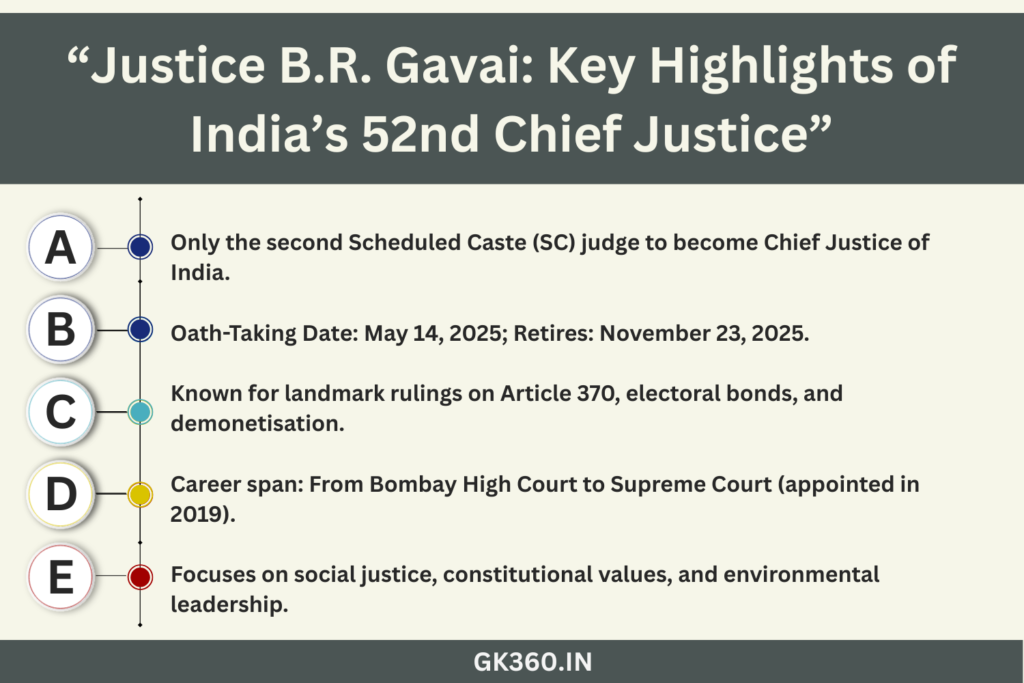Justice B.R. Gavai is India’s 52nd Chief Justice
Introduction: A Historic Moment for India’s Judiciary
India will witness a pivotal moment in its judicial history as Justice Bhushan Ramkrishna Gavai takes the oath as the 52nd Chief Justice of India (CJI). Appointed by President Droupadi Murmu, this landmark occasion is not just a routine succession—it reflects the evolving face of India’s legal system. Justice Gavai becomes only the second individual from the Scheduled Caste (SC) community to rise to this prestigious position, after Justice K.G. Balakrishnan.
With a career that spans nearly four decades and includes influential verdicts on constitutional, electoral, and environmental matters, Justice Gavai’s elevation signals a blend of judicial excellence and social progress. His tenure, though brief, promises to reinforce transparency, inclusivity, and constitutional values at the highest level of India’s judiciary.

Table of Contents
- Introduction
- Who is Justice B.R. Gavai?
- Key Dates and Appointment Timeline
- Significance of His Appointment for Scheduled Caste Representation
- Major Supreme Court Judgments by Justice Gavai
- Justice Gavai’s Career Path: From Bar to Supreme Court
- How is the Chief Justice of India Appointed?
- Implications for India’s Judiciary and Social Equity
- FAQs: Justice Gavai & CJI Appointments
- Conclusion: A Short Tenure, A Lasting Legacy
- Further Reading and Resources
Who is Justice B.R. Gavai?
Justice Bhushan Ramkrishna Gavai is a seasoned jurist with a rich legacy of legal service. Born on November 24, 1960, in Maharashtra, he comes from a family that has long upheld the values of public service and justice. Educated in law and deeply committed to constitutional principles, he began his legal career in 1985 and quickly established himself in the Bombay High Court.
Over the decades, he has handled a broad spectrum of cases, from civil rights to administrative law, and his judicial philosophy emphasizes equity, social justice, and the rule of law.
Key Dates and Appointment Timeline
- Appointment by President: April 30, 2025
- Oath-Taking Ceremony: Scheduled for May 14, 2025
- Term End Date: November 23, 2025 (on his 65th birthday, as per the constitutional retirement age)
- Predecessor: Justice Sanjiv Khanna
- Successor: To be announced based on seniority and eligibility
Justice Gavai’s appointment follows the traditional Memorandum of Procedure (MoP), which prioritizes seniority and outgoing CJI recommendations.
Significance of His Appointment for Scheduled Caste Representation
Justice Gavai’s elevation to CJI is monumental for Scheduled Caste (SC) representation in India’s judiciary. He becomes the second SC judge to lead the apex court after Justice K.G. Balakrishnan (2007–2010). His rise breaks symbolic and systemic barriers, spotlighting the growing inclusivity within India’s top judicial corridors.
This appointment resonates beyond the courtroom—it affirms the constitutional promise of social justice and serves as a beacon for marginalized communities aspiring to leadership roles in governance.
Major Supreme Court Judgments by Justice Gavai
Justice Gavai has played a pivotal role in several landmark rulings that have shaped the nation’s legal and political landscape. His judicial acumen and balanced reasoning have left a lasting imprint.
Article 370 Verdict
Justice Gavai was part of the five-judge Constitutional Bench that upheld the abrogation of Article 370, which granted special status to Jammu and Kashmir. The verdict reinforced the Centre’s authority over state reorganization and was lauded for its constitutional clarity.
Electoral Bonds Ruling
He contributed to the bench that struck down the Electoral Bonds Scheme, declaring it unconstitutional. This judgment promoted transparency in political funding, aligning with democratic principles.
2016 Demonetisation Decision
Justice Gavai was among the 4:1 majority that upheld the demonetisation move initiated by the Government of India. The judgment validated executive authority under the Reserve Bank of India Act and addressed procedural legality.
Reservation Subclassification Judgment
In a landmark seven-judge bench verdict, Justice Gavai ruled in favor of allowing subclassification within SCs for reservation purposes. This decision is vital for intra-community equity and nuanced affirmative action.
No Demolition Without Notice
Authored by Justice Gavai, this judgment mandated that no property demolition can occur without prior notice and a 15-day response window. It was seen as a win for citizens’ rights against arbitrary state action.
Environmental Leadership
Currently, Justice Gavai heads the Supreme Court bench dealing with environmental and forest matters. Under his leadership, the bench has tackled key issues around wildlife protection, afforestation, and environmental clearances.
Justice Gavai’s Career Path: From Bar to Supreme Court
Justice B.R. Gavai’s legal journey is a testament to perseverance, judicial wisdom, and progressive constitutional interpretation. His professional timeline illustrates a steady ascent through India’s judicial system:
- March 16, 1985: Began legal practice after enrolling at the Bar Council.
- November 14, 2003: Appointed as an Additional Judge of the Bombay High Court.
- November 12, 2005: Became a Permanent Judge at the Bombay High Court.
- May 24, 2019: Elevated to the Supreme Court of India.
- May 14, 2025: Scheduled to be sworn in as the Chief Justice of India.
Across these milestones, Justice Gavai has remained an advocate for constitutional integrity, access to justice, and social inclusion.
How is the Chief Justice of India Appointed?
The appointment of the Chief Justice of India (CJI) follows an established Memorandum of Procedure (MoP) and relies on institutional tradition and judicial consensus. Here’s how the process works:
Step-by-Step Process:
- Consultation with Outgoing CJI: The Union Law Minister consults the sitting Chief Justice about their preferred successor.
- Seniority Principle: The most senior judge in the Supreme Court is usually recommended unless exceptional circumstances arise.
- Recommendation by Law Ministry: The Ministry forwards the recommendation to the Prime Minister.
- Presidential Appointment: After Cabinet approval, the President of India formally appoints the next CJI.
Justice Gavai’s appointment adhered to this standard protocol, underlining the system’s consistency and transparency.
Implications for India’s Judiciary and Social Equity
Justice Gavai’s elevation is not just a judicial event—it is a socio-political milestone. It signifies:
- Broader representation in top constitutional positions
- Progress toward social justice for marginalized communities
- Trust in the seniority-based judicial system
- Continued emphasis on balanced development—legal, environmental, and ethical
Though his term is expected to last just over six months, it is poised to make symbolic and practical contributions to India’s judiciary.

FAQs: Justice Gavai & CJI Appointments
- Who is Justice B.R. Gavai?
Justice B.R. Gavai is a senior judge of the Supreme Court and is set to become the 52nd Chief Justice of India. He hails from Maharashtra and is known for his balanced judgments and social justice advocacy. - When will Justice Gavai take oath as CJI?
He is scheduled to take the oath on May 14, 2025, following the retirement of current CJI Justice Sanjiv Khanna. - Why is Justice Gavai’s appointment significant?
He is only the second individual from the Scheduled Caste (SC) community to become CJI, following Justice K.G. Balakrishnan. This promotes inclusivity and representation. - What is his stance on major national issues?
Justice Gavai has supported constitutional clarity in decisions like Article 370, demonetisation, and electoral transparency, reflecting a pragmatic and legally sound approach. - What does the CJI do?
The Chief Justice of India is the head of the Supreme Court and the highest-ranking judicial officer in the country. The CJI leads Constitutional Benches and oversees judicial administration.
Conclusion: A Short Tenure, A Lasting Legacy
Justice B.R. Gavai’s rise to the apex of the Indian judiciary is both historic and inspiring. While his tenure may be brief—ending in November 2025—it is packed with promise. As the nation’s 52nd Chief Justice, his leadership will likely reflect a deep commitment to equity, judicial clarity, and public accountability.
His story reaffirms that India’s judicial landscape is evolving—toward greater diversity, constitutional fidelity, and national service.
Key Takeaways Table
| Aspect | Details |
| Appointment Date | Appointed on April 30, 2025; oath on May 14, 2025. |
| Representation Milestone | Second Scheduled Caste judge to become Chief Justice of India. |
| Major Judgments | Article 370, Electoral Bonds, Demonetisation, Reservation Subclassification. |
| Judicial Philosophy | Emphasis on constitutional clarity, social justice, environmental protection. |
| Tenure Duration | Brief tenure until November 23, 2025 (retirement at 65). |
| Career Path | Practiced since 1985; Bombay High Court Judge (2003–2019); SC Judge since 2019. |
| Appointment Process | Follows Memorandum of Procedure; based on seniority and outgoing CJI advice. |





